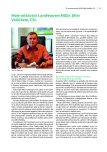Differential diagnostics of hypereosinophilia
Authors:
Michael Doubek 1; Yvona Brychtová 1; Jarmila Kissová 2; Miroslav Tomíška 1; Zdeněk Adam 1
Authors‘ workplace:
Interní hematologická a onkologická klinika LF MU a FN Brno, pracoviště Bohunice, přednosta prof. MUDr. Jiří Mayer, CSc.
1; Oddělení klinické hematologie FN Brno, přednosta prof. MUDr. Miroslav Penka, CSc.
2
Published in:
Vnitř Lék 2014; 60(Suppl 2): 21-27
Category:
70th Birthday - prof. MUDr. Jiří Vorlíček, CSc.
Overview
Hypereosinophilia is characterized by chronic increase of peripheral blood eosinophiles with common damage to various organs due to eosinophilic infiltration and release of mediators. Hypereosinophilia should be both reactive and clonal, and accompanies group of heterogeneous disorders (infectious, pulmonary, immunologic, malignant). Based on recent advances in molecular and genetic diagnostic techniques and increasing experience with differences in clinical features and prognosis, some subtypes of clonal hypereosinophilic syndromes have been defined, such as myeloproliferative variants, including chronic eosinophilic leukemia, and lymphocytic variants, but other subtypes remain undefined. Differential diagnostics oh hypereosinophilie therefore remains one of very important medical issues.
Key words:
differential diagnostics – hypereosinophilia
Sources
1. Swerdlow SH, Campo E, Harris NL et al. WHO classification of tumours of haematopoietic and lymphoid tissues. International Agency for Research on Cancer.4th ed. IARC Press: Lyon 2008. ISBN 9789283224310.
2. Tefferi A, Gotlib J, Pardanani A. Hypereosinophilic syndrome and clonal eosinophilia: point-of-care diagnostic algorithm and treatment update. Mayo Clin Proc 2010; 85(2): 158–164.
3. Tefferi A, Patnaik MM, Pardanani A. Eosinophilia: secondary, clonal and idiopatic. Br J Haematol 2006; 133(5): 468–492.
4. Adam Z, Elbl L, Buliková A et al. Eozinofilie, idiopatický hypereozinofilní syndrom. Postgrad Med 2003; 5(5): 471–487.
5. Lombardi C, Passalacqua G. Eosinophilia and diseases: clinical revision of 1862 cases. Arch Intern Med 2003; 163(11): 1371–1373.
6. Méndez-Sánchez N, Chávez-Tapia NC, Vazquez-Elizondo G et al. Eosinophilic gastroenteritis: a review. Dig Dis Sci 2007; 52(11): 2904–2911.
7. Kobayashi S, Inokuma S, Setoguchi K et al. Incidence of peripheral blood eosinophilia and the threshold eosinophile count for indicating hypereosinophilia-associated diseases. J Allergy 2002; 57(10): 950–956.
8. Chrobák L, Voglová J. Idiopatický hypereozinofilní syndrom a chronická eozinofilní leukemie. Vnitřní Lék 2005; 51(12):1385–1393.
9. Campos LE, Pereira LF. Pulmonary eosinophilia. J Bras Pneumol 2009; 35(6): 561–573.
10. Simon HU, Plotz SG, Dummer R et al. Abnormal clones of T cells producing interleukin-5 in idiopathic eosinophilia. N Engl J Med 1999; 341(15): 1112–1120.
11. Yoo TJ, Orman SV, Patil SR et al. Evolution to eosinophilic leukemia with a t(5:11) translocation in a patient with idiopathic hypereosinophilic syndrome. Cancer Genet Cytogenet 1984; 11(4): 389–394.
12. Cools J, DeAngelo DJ, Gotlib J et al. A tyrosine kinase created by fusion of the PDGFRA and FIP1L1 genes as a therapeutic target of imatinib in idiopathic hypereosinophilic syndrome. N Engl J Med 2003; 348(13): 1201–1214.
13. Pardanani A, Brockman SR, Paternoster SF et al. FIP1L1-PDGFRA fusion: prevalence and clinicopathologic correlates in 89 consecutive patients with moderate to severe eosinophilia. Blood 2004; 104(10): 3038–3045.
14. Cross NC, Reiter A .Fibroblast growth factor receptor and platelet-derived growth factor receptor abnormalities in eosinophilic myeloproliferative disorders. Acta Haematol 2008; 119(4): 199–206.
15. Ommen SR, Seward JB, Tajik AJ. Clinical and echocardiographic features of hypereosinophilic syndromes. Am J Cardiol 2000; 86(1): 110–113.
16. Blatt PM, Rothstein G, Miller HL et al. Loffler’s endomyocardial fibrosis with eosinophilia in association with acute lymphoblastic leukemia. Blood 1974; 44(4): 489–493.
17. Doubek M, Kozák T, Vašků V et al. Systémová mastocytóza. Vnitř Lék 2010; 56(Suppl 2): 2S188–2S194.
Labels
Diabetology Endocrinology Internal medicineArticle was published in
Internal Medicine

2014 Issue Suppl 2
Most read in this issue
- Differential diagnostics of hypereosinophilia
- Palliative medicine and the „good death“
- Patient follow-up after treatment of breast, colorectal and prostate cancer
- Ph-negative myeloproliferative diseases with thrombocythemia in the context of Thromboreductin® treatment, data from registry 2013
